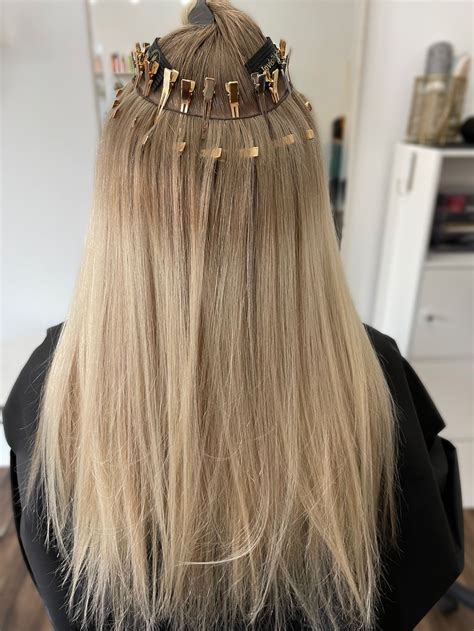Introduction

Yearning for luscious, voluminous locks that turn heads? Tie-in extensions offer the perfect solution to transform your hair and elevate your style. With their seamless integration and natural-looking results, these extensions are a game-changer for those seeking to achieve their hair goals.
Benefits of Tie In Extensions
- Enhanced Volume: Tie-in extensions add instant volume to thin or flat hair, creating a fuller, more luxurious appearance.
- Length Transformation: Extend your hair to your desired length, from subtle enhancements to dramatic transformations.
- Natural Look: Skilled stylists carefully place the extensions to blend seamlessly with your natural hair, ensuring a flawless finish.
- Versatility: Tie-in extensions offer endless styling possibilities, from loose curls to sleek blowouts and elegant updos.
- Damage-Free Installation: Unlike some other extension methods, tie-in extensions do not require heat or chemicals, minimizing damage to your natural hair.
Different Types of Tie In Extensions
- Tape-in Extensions: Thin, flexible tape-like sections that are attached to your hair using a medical-grade adhesive.
- Beaded Weft Extensions: Human hair wefts sewn onto beads that are then tied or clamped to your hair.
- Fusion Extensions: Keratin-tipped strands of hair that are attached using heat, creating a strong bond.
Factors to Consider When Choosing Tie In Extensions
- Hair Type: Extensions should match the texture and color of your natural hair for a seamless transition.
- Lifestyle: Consider your daily routine and haircare habits to select extensions that fit your lifestyle.
- Desired Volume and Length: Determine the amount of volume and length you want to achieve to ensure the extensions meet your expectations.
- Budget: Tie-in extensions vary in cost depending on the type, length, and quality of hair used.
Application and Maintenance
- Professional Installation: Seek a skilled hairstylist certified in tie-in extension application to ensure proper placement and blending.
- Regular Maintenance: Extensions require regular brushing, washing, and conditioning to keep them looking healthy and vibrant.
- Relocation: Extensions typically need to be repositioned every 6-8 weeks as your natural hair grows.
- Removal: Extensions can be safely removed by a professional hairstylist to prevent damage to your natural hair.
Cost Considerations
According to a 2023 study by the American Academy of Cosmetic Surgery, the average cost of tie-in extension installation ranges from $500 to $2,000. The cost varies depending on the type of extensions, length, number of strands applied, and the salon’s location and experience.
Innovative Applications for Tie In Extensions
Beyond enhancing volume and length, tie-in extensions can be used for a variety of creative applications:
- Custom Coloring: Integrate extensions into your hair to create dramatic color effects, such as ombré, balayage, and highlights.
- Temporary Hair Transformation: Achieve temporary hair makeovers for special occasions or events without permanently altering your natural hair.
- Hair Repair: Extensions can be used to conceal damaged hair sections, such as split ends or breakage.
Tips and Tricks for Tie In Extensions
- Consult a Trusted Stylist: Seek the advice of a reputable hairstylist to find the extensions that best suit your hair type and desired style.
- Invest in Quality Hair: Opt for extensions made from high-quality human hair for a natural look and longer lifespan.
- Match Your Natural Hair Color: Ensure the extensions match the shade of your natural hair to achieve a seamless blend.
- Avoid Excessive Heat: Limit the use of heat styling tools on extensions to prevent damage and premature wear.
- Regularly Maintain Your Extensions: Follow the hairstylist’s care instructions for washing, conditioning, and brushing to keep your extensions looking their best.
FAQs about Tie In Extensions
1. How long do tie-in extensions last?
With proper care and maintenance, tie-in extensions can last up to 6 months, depending on the type of extensions and your hair growth rate.
2. Can tie-in extensions damage my natural hair?
When applied and removed professionally, tie-in extensions do not damage your natural hair. Improper application techniques, excessive heat, or neglect can lead to breakage or damage.
3. Are tie-in extensions visible?
When applied correctly, tie-in extensions should be undetectable and blend seamlessly with your natural hair.
4. Can I style tie-in extensions like my natural hair?
Yes, you can style tie-in extensions using the same tools and techniques you use for your natural hair. However, it is recommended to avoid excessive heat to prolong their lifespan.
5. Can I swim or exercise with tie-in extensions?
Avoid swimming or exercising immediately after getting extensions installed. Once they have settled in (usually after 24 hours), you can participate in most activities with caution.
6. How often should I get my tie-in extensions moved up?
As your natural hair grows, the extensions will need to be repositioned to prevent tension and damage. The recommended frequency for relocation is every 6-8 weeks.
7. Can I cut or color tie-in extensions?
Yes, you can cut and color tie-in extensions. However, it is recommended to have a professional hairstylist perform these services to maintain the integrity of the extensions.
8. How much do tie-in extensions cost?
The cost of tie-in extensions varies depending on the type of extensions, length, number of strands applied, and the salon’s location and experience. A typical installation can range from $500 to $2,000.
Conclusion
Tie-in extensions offer a transformative solution for achieving the hair of your dreams. By enhancing volume, length, and style, these extensions empower you to express your individuality and embrace your unique beauty. With proper care and maintenance, tie-in extensions can become a valuable asset in your haircare routine, providing you with the confidence to turn heads wherever you go.
